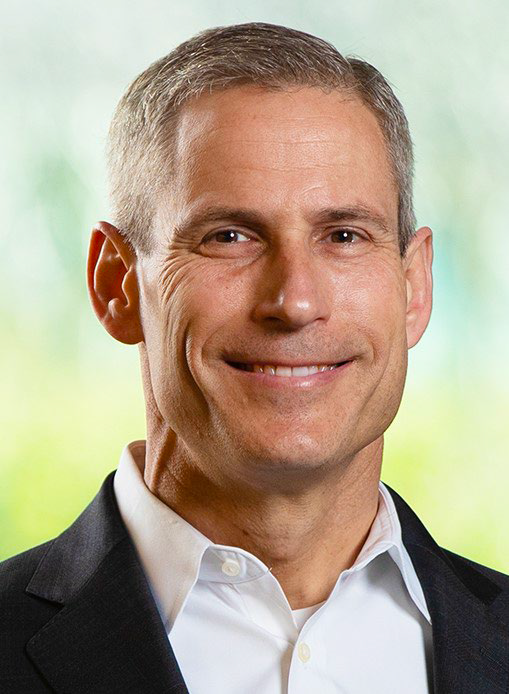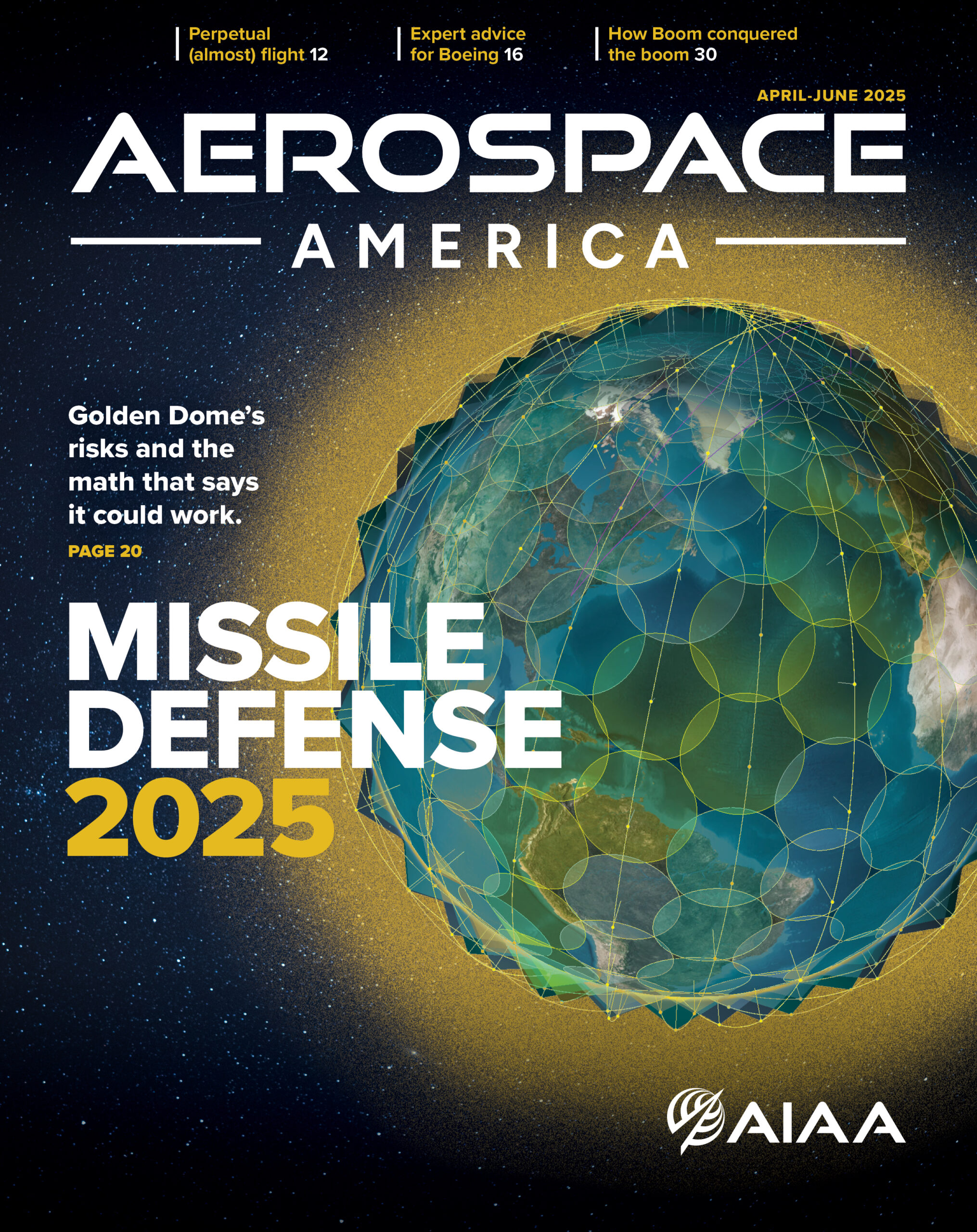Stay Up to Date
Submit your email address to receive the latest industry and Aerospace America news.
Each AIAA President-Elect helps guide the Institute, first as a member of the Board of Trustees and then as President beginning a year later. For the 2025 general election, Keoki Jackson of The MITRE Corporation is running unopposed and will become President-Elect in May. We spoke to Jackson about his career experience and his vision for AIAA.
What sparked your interest in aerospace? How did you get into this line of work?
I’ve been an aviation and space nerd since I was a kid. In grade school, I followed the Voyager missions and saw the images coming back from the outer planets. I kept up with the Space Shuttle development and I remember very clearly watching the first drop tests. Those were formative memories. And although I wasn’t old enough to take the FAA private pilot exam, I had taken the class and done all the testing, just couldn’t do it for a score.
Then it was a freshman year seminar course at MIT that opened my mind to the breadth of things you could do in aerospace engineering and scientific research, and I went full force into aerospace.
What was your career path?
My work has focused on national security systems, secure communications for the military, GPS, and missile warning systems. I’ve led the development of these systems and worked very closely with the operators. I’ve spent quite a bit of time on technology development as CTO, leading the R&D efforts for Lockheed Martin. I’ve had the chance to work across a whole range of products from hypersonics, high-speed flight, and security of our space systems to where we’re going in the future with highly distributed systems and defending the national security spectrum. These were opportunities to shape the direction of where we were going as a nation.
At MITRE I’m working very closely with the U.S. government, and I lead the National Security Engineering Center (NSEC). I sit at the intersection of R&D investments, not just on things that fly but how to integrate all these systems to make a difference; reliable position, navigation, and timing; getting assured communications across all domains; having the intelligence surveillance and reconnaissance provided by incredible aerospace systems; and all the connectivity that makes it work together.
What was your experience with AIAA as a student, young professional, and now?
From my early days through student branch involvement and many events I have attended, AIAA has been with me. I look back on my time as a student with AIAA and remember the amazing opportunity to interact with individuals like Neil Armstrong and Buzz Aldrin, the heroes and legends of the Apollo era, who were engaged with AIAA.
As I got into my research program, I served on the Life Science and Systems Technical Committee which was eye-opening. A lot of times you’re really immersed in your research in the lab. To take a step back and engage with some brilliant people who are connected globally, who have a vision of where this piece of research is going, was really inspiring to me. AIAA conferences were another opportunity to be a part of shaping where we were going in that technology area.
In grad school, I worked on two Space Shuttle missions on experiments, testing astronauts to see how they adapted to the space environment and how they readapted when they come back to Earth. I spent time at NASA Johnson Space Center and Cape Canaveral preparing astronauts for their missions and testing them when they came back. Those were amazing opportunities to engage with my research teams and others who were members of AIAA.
As my career progressed, I was a part of more development work and that led me back to AIAA in more senior roles. I could see the value in what the Council of Directors and AIAA Regions were doing through the events being hosted in different parts of the country.
 Dana “Keoki” Jackson CURRENTLY: Senior Vice President and General Manager, MITRE National Security Sector, responsible for the strategic growth and execution of programs supporting Department of Defense, Department of Justice, and the Intelligence Community. He also leads the National Security Engineering Center.NOTABLE: Jackson joined MITRE after more than two decades at Lockheed Martin, where he shaped the design, development, deployment, and flight operation of major national security spacecraft and programs. Before joining Lockheed Martin, Jackson was a NASA research fellow at the Massachusetts Institute of Technology (MIT) in the field of human adaptation to the space environment. Jackson is an AIAA Fellow and a Fellow of the United Kingdom Royal Aeronautical Society. He was elected to the National Academy of Engineering in 2020.
Dana “Keoki” Jackson CURRENTLY: Senior Vice President and General Manager, MITRE National Security Sector, responsible for the strategic growth and execution of programs supporting Department of Defense, Department of Justice, and the Intelligence Community. He also leads the National Security Engineering Center.NOTABLE: Jackson joined MITRE after more than two decades at Lockheed Martin, where he shaped the design, development, deployment, and flight operation of major national security spacecraft and programs. Before joining Lockheed Martin, Jackson was a NASA research fellow at the Massachusetts Institute of Technology (MIT) in the field of human adaptation to the space environment. Jackson is an AIAA Fellow and a Fellow of the United Kingdom Royal Aeronautical Society. He was elected to the National Academy of Engineering in 2020.
AIAA RECORD: Joined the Institute in 1995; Class of 2019 AIAA Fellow. Life Sciences and Systems Technical Committee Member (1999–2003); AIAA Foundation Board Trustee (2015–2020); AIAA Board of Trustees Member (2023–2026 term); and Finance Committee Member (2023–present).
EDUCATION: Bachelor’s, Master’s, and Ph.D. degrees in aeronautics and astronautics from MIT. Completed the Stanford Executive Program at the Stanford Graduate School of Business.
Why do you have such a passion for the AIAA Foundation?
I spent time as a Foundation Trustee with other Corporate Members working to get corporate donations to support activities focused on uplifting future AIAA members. The Foundation is focused on STEM development and bringing students and educators to a wide range of activities that will inspire the next generation.I’m deeply grateful to Lockheed Martin for their incredible support to the AIAA Foundation, and recognize Northrop Grumman, Raytheon, Boeing, and many more, who have invested in it. The big corporate donations are important to sustain the Foundation for the future. But the Foundation is the members; it’s the everyday donations from individuals who care what’s going to happen next in aerospace, who are looking at the next generation. A big shout out to our members for their continued support of the Foundation!In your election statement, you talked about engaging AIAA volunteers and staff through four focus areas. Can you elaborate on how you will do this?
My role as President-Elect and President is an opportunity to support our staff and our volunteers with what they’re doing every day, and to shine a light on the important work that AIAA is doing. We also need to get AIAA on sustainable, long-term financial footing, and increase engagement with volunteers, aligning their activities to the overall mission and improving their leadership development. I broke this work into these four areas:
1. Strengthening partnerships with industry, government, and academia that enable the Institute and the AIAA Foundation. The opportunities for our members are inherently linked to the engagement and support of these organizations. As we increase those partnerships, we’ll increase the leverage and advantage for AIAA and, ultimately, for the development of our members and the impact that they have on the missions they’re supporting every day. We’re going to have to build ties with new people and the many new startup companies. What can AIAA do to make this next generation of organizations a success? We need to bring them into our ecosystem and show them how AIAA is relevant to them.
2. Building our international stature. AIAA is the premier aerospace professional society in the world, but we are largely U.S. centric. There’s an incredible opportunity to get our vision and value proposition out there globally and partner with organizations such as IAF, ICAS, the Royal Aeronautical Society, and similar organizations in other countries, who are creating incredible new capability and capacity, and encouraging research and development partnerships.
3. Championing our members, and particularly the growth and development of our members and diversity initiatives. We aspire to be an organization that reflects the society that we live in. I see a few ways to do this – increasing visibility with other organizations, like the National Academies, that are devoted to similar professional and STEM development, and also reaching out to the breadth of academic organizations that are creating the next generation of talent. We also need to do everything we can to support the Foundation’s efforts to develop the future workforce pipeline.
4. Recognizing our members’ impact across sponsoring organizations. A lot of what AIAA does is shine a light on the incredible work that our members do and how it impacts society, our citizens, and health, safety, and prosperity around the world. Our Board of Trustees and volunteer leaders can amplify these honors and our message to shine a light on what AIAA is doing and what our members are doing, which inspires even more people to take on the challenges of the aerospace industry.
AIAA, like many professional societies, has faced membership and financial challenges. How does the Institute turn that around?
All professional organizations have seen changes in their membership and have had problems recruiting and retaining members, resulting in financial challenges. Additionally, the pandemic disrupted conferences and big events. I have to recognize the tremendous work by Dan Dumbacher and the disciplined work by the Board of Trustees and our volunteers over the past few years. We’ve seen a better-than-expected turnaround in some of the financial challenges, so kudos to the team. There’s tremendous excitement about the future of aerospace and we need to grab hold of that to grow. We should examine our relevance for the membership and the challenges they face today.
What do you think would mark a successful presidential tenure?
I see it as 1) supporting the AIAA CEO and staff in implementing the strategy; 2) getting greater visibility across all the institutions that support AIAA that fund aerospace research and development, including the U.S. government and Congress but also our international partners; 3) forming new international partnerships with like-minded organizations that take our profession to new heights; and 4) providing more opportunities and more venues to showcase the impact that our members are having every day on billions of people around the world.
About AIAA Communications
Stay Up to Date
Submit your email address to receive the latest industry and Aerospace America news.




